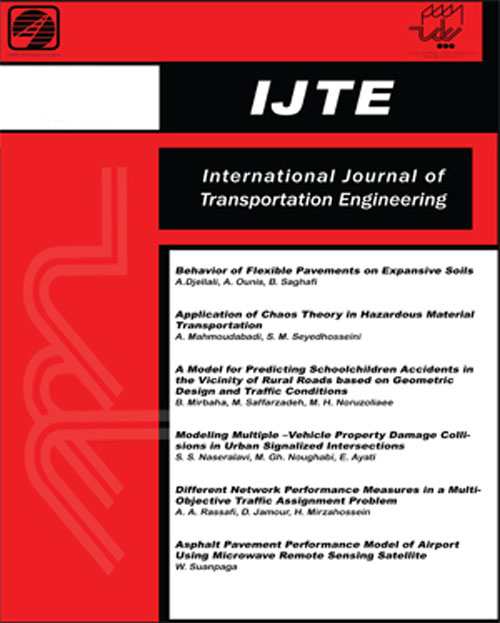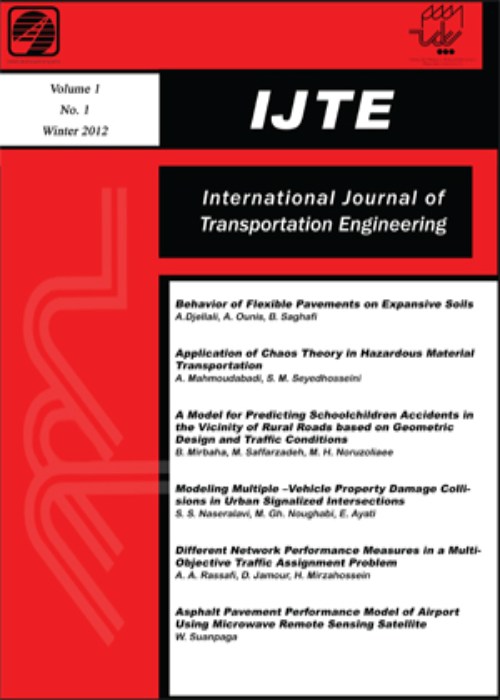فهرست مطالب

International Journal of Transportation Engineering
Volume:4 Issue: 2, Autumn 2016
- تاریخ انتشار: 1395/10/05
- تعداد عناوین: 6
-
-
Pages 75-86In weaving section due to a strong need for lane changing, a type of turbulence is created in traffic flow; so, the speed and the capacity of the weaving section decreases. Therefore, investigation of the weaving section is very important. However, due to shortage of the manual for urban principal arterials (highways), calibration of these models is necessary. One of these models that are used to evaluate the level of service of the weaving sections is speed model which will be developed in this paper. Thus, data of the lane-changing rates and travel time (speed) have been collected in 9 principal arterials of Tehran. Then, two models for estimating of weaving and non weaving speed are developed. Validations also confirm the accuracy of the developed models. Exploration of these developed models reveals that speed decreases by increasing the weaving intensity. In addition, Comparison of the developed models and HCM 2010 for similar condition shows that the developed models estimate more than the HCM 2010 model.Keywords: Weaving speed, non, weaving speed, weaving section, urban principal arterials
-
Pages 87-96Pedestrians are the most vulnerable road users. For evaluating and modifying pedestrian safety in unsignalized crosswalks, the first important issue is to identify and explore factors affecting the interaction behavior of pedestrians and vehicles in conflict areas. By analyzing those factors and determining how they affect road user's behavior, we can represent the plans and procedures to promote awareness and safety of both pedestrians and drivers. The goal of this article is to study pedestrian decision making behavior in unsignalized crosswalks and to determine factors affecting the crossing behavior in conflict areas. The supposed goal of this study was assessing how each factor can influence pedestrian-vehicle conflict behavior by means of developing logistic regression models.This work explores a variety of factors that may impact the gap acceptance behavior of pedestrian to provide a promising decision model. Discrete choice (probit) models of the gap acceptance decision are estimated from observations of pedestrians behavior when crossing at conflict zone. Analysis results show that variables like vehicle speed change (VSC), pedestrian distance to vehicle lane (PDV), pedestrian age (PA) and vehicle position to the start point of pedestrian (Vp) are effective in Pedestrian gap Acceptance (PGA). Modeling decision making behavior by logit models, resulted in neglected R Square of 0.882 and correct classification of 94.9 pair wise cases. Area under ROC curve resulted in 0.98 that means the reliability of models is extracted. The results also showed that some variables like vehicle type (VT), waiting time (WT), number of pedestrians walking in a group (PN) and Gap or Lag are not effective in decision making logit models.Keywords: Pedestrian, conflict zone, gap acceptance, logit models
-
Pages 97-107The performance of asphalt binders at high and low temperatures has an important role on the rutting and cracking resistance of asphalt pavements. Crumb Rubber Modified (CRM) is one of the asphalt modifiers that improves asphalt physical and mechanical properties and helps reducing environmental pollution. In this research, three unmodified and six CRM modified binders were tested using the Superpave test and Performance Grading (PG) system. The Multiple Stress Creep and Recovery (MSCR) test was used to assess rutting resistance of rubberized binders. The study compared the results of this classification with the 7 performance grade binders required for specific climatic zones in Isfahan Province. The results show that, CRM improves asphalts physical and mechanical properties at service temperatures and decrease in the non-recoverable compliances (Jnr) in MSCR test. Moreover, CRM binder is sufficient for the required PGs, while based on MSCR test, it cannot fully cover the traffic level requirements in Isfahan Province.Keywords: Crumb rubber, asphalt binder, traffic compatibility, MSCR test, rheological properties
-
Pages 109-126Car-following models are among the most important components of micro traffic flow simulation which is studiedby transportation experts to evaluate new applications of intelligent transportation systems. Until now, several carfollowing models have been proposed. An obvious disadvantage of the former models is the great number of parameters which are difficult to calibrate. In this paper, a car-following model was modeled and developed by combining an Adaptive Neuro-Fuzzy Inference System (ANFIS) and a Classification And Regression Tree (CART) to simulate and predict future behavior of each driver-vehicle-unit (DVU). In this model, the reaction time was instantaneously calculated based on the time interval between acceleration and relative velocity by the proposed model and was consideredas a new input. The results were compared with the fixed reaction time and the reaction time proposed by Ozaki. To evaluate the performance of the model, we compared the proposed model's output data with real conditions and it was found that the precision of the proposed model was significantly high with regard to the instantaneous reaction time. According the implemented simulation, the proposed model reached a good validity on the basis of proximity to a real situation of car-following.Keywords: Traffic engineering, Car following modeling, reaction time, microscopic simulation, intelligent transportation system (its)
-
Pages 127-136Although there are remarkable differences in drivers behavior as well as vehicles characteristics, road capacity estimationmethods in developing countries are same as developed ones. So, the discrepancy between the theoretical and practical values of capacity is inevitable. Although, capacity estimation methods can be classified based on numerous parameters, in developing countries, the availability of data is a remarkable factor to choose the appropriate method. Headway method is one of the most popular methods which is used to estimate capacity of basic freeways section regarding to the lack of available data in developing countries such as Iran. According to headway method theory, the distribution function of headways needs to be estimated in order to find the capacity of a road facility. However, in previous studies the mean of observed headway is used for capacity estimation. The data applied in this study have been collected from Iran. Modelling had accomplishedin 2 steps: 1) Filtering the input data that are related to following vehicles and just before queue. 2) Statistical modelling using the Minitab 16 software. Evaluating models by three parameters (applicability, validity and reasonability), it was proven that the lognormal distribution functions, is the best fit to observed data. According to results, the capacity of the basic freeway section is 12% less than the values proposed by HCM, which are the current bases for traffic studies in developing countries such as Iran.Keywords: Capacity, headway, following vehicle, follower vehicle
-
Pages 137-146Vehicle occupants comprise a considerable proportion of traffic crash victims in Iran. This paper has focused on vehicle occupants injury severity and employed the Classification and Regression Tree (CART)technique in order to identify the most important variables affecting the injury severity of these road users in crashes occurred on rural freeways and multilane highways in Iran over a three year period (2006-2008). In the procedure adopted in this paper, the problem of three-class prediction was decomposed into four binary prediction models. Results revealed a high overall prediction accuracy of the models. Ten explanatory variables were considered in the current study in order to find the most important variables affecting the injury severity of occupants. In this regard, some if-then rules pertaining to the conditions that lead to more severe injuries are provided based on the decision tree analysis. Results confirm the already-known importance of seatbelt usage for preventing serious injuries in one hand, and imply the insufficiency of seatbelt usage for protecting the occupants from receiving serious injuries in some collision types, on the other hand. This underscores the need for more safety instruments (especially airbags for all occupants of the vehicle) to be installed in passenger cars in Iran.Keywords: Vehicle occupant, seat belt, injury severity, rural freeway, multilane highway


